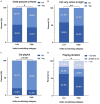Evaluating undesired scratching in domestic cats: a multifactorial approach to understand risk factors
- PMID: 39021412
- PMCID: PMC11251885
- DOI: 10.3389/fvets.2024.1403068
Evaluating undesired scratching in domestic cats: a multifactorial approach to understand risk factors
Abstract
Introduction: Despite being a natural feline behavior, scratching can become undesirable from a human perspective when directed at household items. This complex behavior can stem from various motivations, ranging from individual cat characteristics to environmental factors. This study investigates the factors influencing the increased level of undesirable scratching behavior in domestic cats, considering both cat-related and environmental aspects.
Methods: Data from 1,211 cats were collected for this study. An online questionnaire comprising three sections was utilized. The first section gathered caregiver demographics, while the subsequent section examined aspects of cats' daily routines, social interactions, environments, behaviours, and temperaments. The final section assessed the frequency and intensity of undesirable scratching behavior in cats. Scratching behavior was evaluated based on a combined scratching index.
Results: The study suggests that the presence of a child may be associated with scratching episodes in the home environment. Additionally, factors such as play duration, playfulness, and nocturnal activity were identified as significant contributors to heightened scratching levels (p ≤ 0.05). Aggressiveness and disruptiveness also played significant roles in increased scratching behavior (p ≤ 0.05). The location of scratching posts emerged as a significant factor, with posts placed in areas frequented by the cat being more effective in redirecting scratching behavior (p ≤ 0.05).
Discussion: This study reveals several significant associations between cat characteristics, nocturnal activity and play, as well as the environment. It underscores the multifaceted nature of undesirable scratching behavior and emphasizes the importance of comprehensively understanding both the individual characteristics of the cat and its environment to effectively address this behavior.
Keywords: behavioural characteristics; cat behavior; domestic cat; environmental factors; undesired scratching.
Copyright © 2024 Demirbas, Pereira, De Jaeger, Meppiel, Endersby and da Graça Pereira.
Conflict of interest statement
XJ, LM, and SE were employed by Ceva Santé Animale. The remaining authors declare that the research was conducted in the absence of any commercial or financial relationships that could be construed as a potential conflict of interest. The authors declare that this study received funding from Ceva Santé Animale. The funder had the following involvement in the study: data collection.
Figures
Similar articles
-
Efficacy of the Feliway® Classic Diffuser in reducing undesirable scratching in cats: A randomised, triple-blind, placebo-controlled study.PLoS One. 2023 Oct 18;18(10):e0292188. doi: 10.1371/journal.pone.0292188. eCollection 2023. PLoS One. 2023. PMID: 37851638 Free PMC article. Clinical Trial.
-
Scratching behaviour and its features: a questionnaire-based study in an Italian sample of domestic cats.J Feline Med Surg. 2013 Oct;15(10):886-92. doi: 10.1177/1098612X13481468. Epub 2013 Mar 14. J Feline Med Surg. 2013. PMID: 23492353 Free PMC article.
-
Owner observations regarding cat scratching behavior: an internet-based survey.J Feline Med Surg. 2016 Oct;18(10):791-7. doi: 10.1177/1098612X15594414. Epub 2015 Jul 15. J Feline Med Surg. 2016. PMID: 26179574 Free PMC article.
-
Feline scratching and destruction and the effects of declawing.Vet Clin North Am Small Anim Pract. 1991 Mar;21(2):265-79. doi: 10.1016/s0195-5616(91)50032-2. Vet Clin North Am Small Anim Pract. 1991. PMID: 2053250 Review.
-
Conspecific and Human Sociality in the Domestic Cat: Consideration of Proximate Mechanisms, Human Selection and Implications for Cat Welfare.Animals (Basel). 2022 Jan 25;12(3):298. doi: 10.3390/ani12030298. Animals (Basel). 2022. PMID: 35158622 Free PMC article. Review.
References
-
- Pereira GDG, Fragoso S, Morais D, de Brito MTV, de Sousa L. Comparison of interpretation of cat's behavioral needs between veterinarians, veterinary nurses, and cat caregivers. J Vet Behav. (2014) 9:324–8. doi: 10.1016/j.jveb.2014.08.006 - DOI
LinkOut - more resources
Full Text Sources
Miscellaneous



